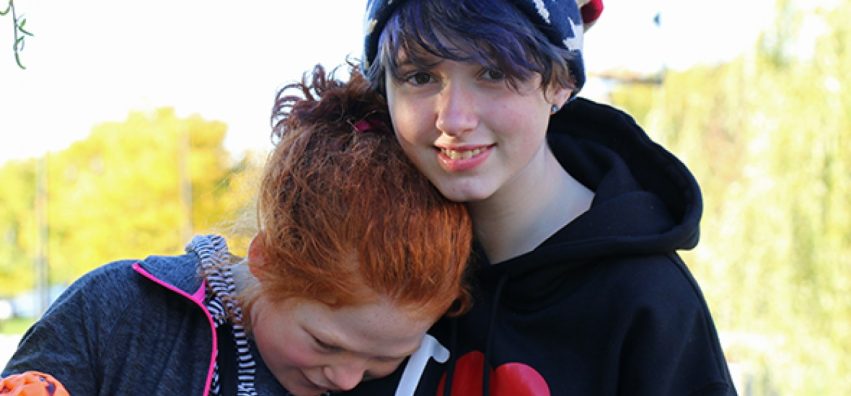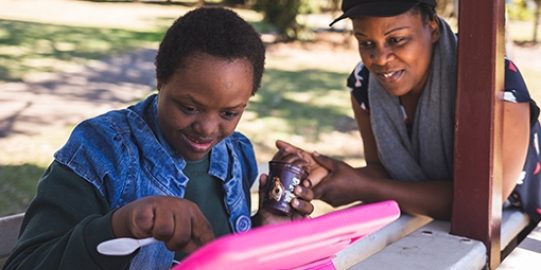Finding a way to access language
Communication, however, was still elusive. I presumed this was the result of her genetic syndrome. Maggie has Angelman syndrome, so her failure to learn language was surely a function of her disability. But Maggie was different even from her peers with Angelman. She often appeared to live in a world without language. She was acutely aware of everything we did, always watching for cues about what was coming next, but did not seem to tune into speech and rarely responded to the words we spoke. Strangers, and even classmates, often assumed she was deaf. Maggie learned to use her body to become more expressive, but in speech therapy, she failed to match photos or to consistently make requests. She was provided a 4-button speech output device. When she refused to use it, it was replaced with two single-message voice output buttons; one was recorded to say “more, please” and one said “all done”. She used them as projectiles rather than for requests. I trusted the speech and language professionals who told me this was evidence-based practice, and I presumed that Maggie’s failure to learn to use the buttons was the result of her own disabilities.
Then a special educator named Mary-Louise Bertram began sharing stories of children like Maggie who communicated on a range of topics. They weren’t just making requests or pointing to the correct answer. They were expressing ideas no one knew they were thinking. Mary-Louise explained that when it comes to Augmentative and Alternative Communication (AAC), the presumption of competence is that children who cannot use speech require long periods of time simply observing a model of language that they, too, can access and explore. They require rich interactions with language and other people, around the things they are noticing and learning, just like their typical peers. Her students were immersed in models of adults using their same AAC to communicate all day long. This modeling was like building a ramp that allowed the children to access to the words in their AAC. Mary-Louise argued that if we provide our complex children with the same learning environment and opportunities and experiences that typical kids require to develop language, and if we provide quality instruction and create access to appropriate technology, even our most complex kids can access language.
I watched countless videos of modeling AAC. It didn't seem too hard. Just point to visual symbols on Maggie’s AAC while talking; how hard could that be? But learning to model AAC with Maggie was challenging. First, I had to develop new habits, like always having her Proloquo2Go turned on and within arm’s length. We needed an extra iPad and laminated copies of her vocabulary so that we had multiple tools to model. And then there was Maggie herself. She turned her head away when I tried to model her AAC. She left the room if I persisted. She shoved the iPad away. It seemed she already felt that speech bombarded her; how would adding symbols improve this? All the success stories I saw on social media were kids who seemed to already understand language and were deeply motivated to learn how to use it. I struggled to presume Maggie’s competence, that language could ever be meaningful to her.
What did presuming competence mean for us?
When I admitted that I wasn’t sure Maggie understood much spoken language, other parents told me to presume competence: to them, “presume competence” meant I should just presume she understood speech. But her struggle with receptive language was real: presuming she understood everything I said wouldn’t change that. Maggie has a disability that profoundly impairs her ability to process spoken language. I slowly realized that the presumption of competence meant we must explore new opportunities, experiences, environments, technology, and instruction to support her processing.
I realized that presuming competence in Maggie is really presuming it in myself.
When I presume competence, I am presuming that I can learn how to accommodate her disabilities and support her to learn. I learned how to present symbol displays to my daughter while standing with my back to her, bringing it into view only on the periphery of her vision. Before, I had thrust symbol displays and her Proloquo2Go right into her face; no wonder she turned away! I learned how to use the core words on her Proloquo2Go home page to speak in short sentences. I learned how providing the visual of her Message Window enhanced her comprehension. I learned how the text-to-speech electronic voice was much more consistent - and often easier for her to comprehend - than my own voice. I believe that Maggie began to attend to language only after oral speech was presented visually. Spoken words were so fleeting, but visuals persisted long enough for her to process them. I learned that my daughter is intensely visual and struggles to both look and listen at the same time. I learned not to speak while using her symbols, but just let the symbols speak for themselves. I learned to give her much more time to process what I had said and consider her response.
Presuming competence has meant presuming that what Maggie needs to develop language is the same as what any child needs: lots of people speaking her language with her for many different reasons. Presuming competence means we are capable of figuring this out. It has meant that each setback or failed experiment was part of our own learning process, weeding out that which doesn’t work.





